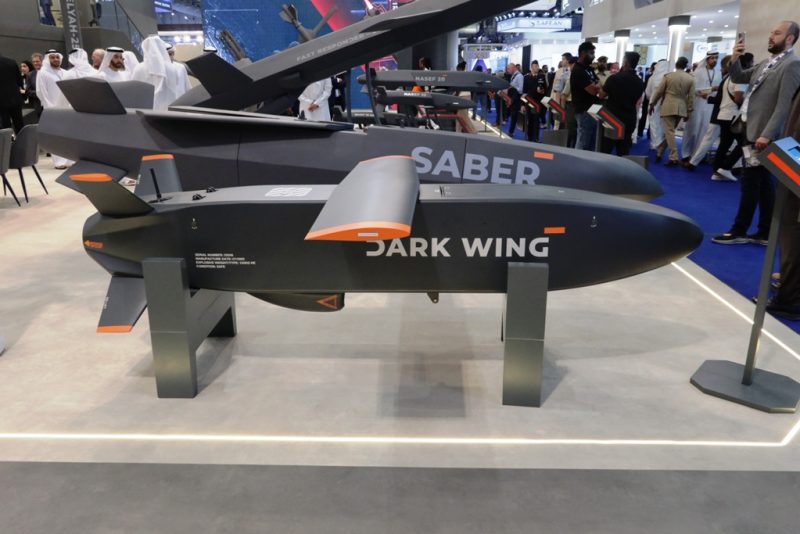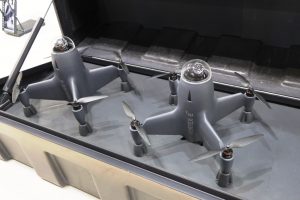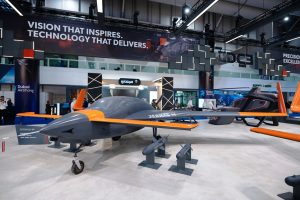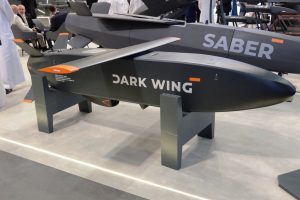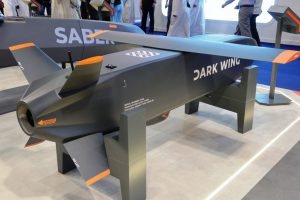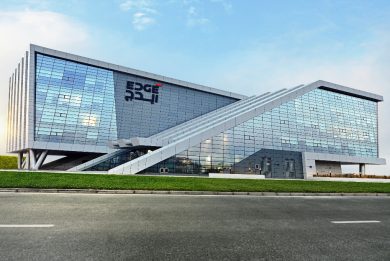Dubai Airshow 2025 – ADASI unveils unmanned solutions ranging from C-UAS to MALE to precision guided munitions, widening the scope of EDGE portfolio
At the Dubai exhibition several new products were exhibited by ADASI, the unmanned systems company part of EDGE Platforms and Systems cluster. While the Vortex-E is a small interceptor dedicated to neutralise incoming drones, the Jernas family of UAVs ensures long-range long-endurance reconnaissance and strike capability, the Dark Wing being a low-cost mass-producible high-speed precision guided munition with modular payload capability
The increasing threat coming from UAVs of different types led EDGE to enter the C-UAS interceptor field with the Vortex-E, an eye-catching small unmanned system which features an aerodynamic fuselage to which four short wings are fitted, each carrying at its extremity a nacelle containing an electric motor powering a two-blade propeller/rotor. The mass of the Vortex-E is an interceptor-strike drone designed to destroy incoming enemy UAVs. Small, low cost, and highly accurate it neutralises the threat exploiting the lethal effect of its payload. This has a mass of 1-2 kg over the 4-6 kg take-off mass of the drone.
Asked about these brackets in terms of mass Marcus de Jonge, Chief Development Officer at ADASI told EDR On-Line that this has much to do with the modular approach that EDGE has. “In EDGE as well as in ADASI we are going for modular, adaptable designs on all our platforms. The Vortex-E just follows the same principle of our products, where we need flexibility and we design for modularity that can cater for a variety of payloads,” he said, adding that a trade-off between payload and range will be possible, reducing the payload mass to carry more “fuel”, which in the case of this specific system should mean a bigger battery, which would allow a 15-36 minutes endurance, which is reduced to six minutes when the 2 kg payload is installed, the range bracket varying between 24 and 15 km. Speed is a key factor when intercepting an attacking drone, the Vortex-E propulsion system allowing the interceptor to reach speeds between 240 and 350 km/h, the system being able to reach a maximum altitude of 8,000 ft.
No details were provided on the payload, which should be of the high explosive fragmentation type, triggered by a proximity fuse. To be effective the hard-kill interceptor must reach a position within the warhead lethal range, a direct hit also exploiting the Vortex-E kinetic energy being also a possibility, especially when bigger drones need to be taken off from the sky. At the front of the fuselage a small gimballed electro-optic sensor can be seen; it is based on a thermal camera that ensures day/night capability. To ensure maximum accuracy the Vortex-E can be used with full manual control, as a First-Person View system, the operator manoeuvring it thanks to a radio link, or locking on the target exploiting AI-based algorithms. Integrated with a radar, it can become fully autonomous.
Prototypes are already flying, opening the flight envelope in a spiral approach. A vertical take-off airframe, the Vortex-E then transitions in horizontal flight accelerating and manoeuvring to reach its target; as usual the most critical phase is the transition from vertical to horizontal flight, when rotors lift gives place to aerodynamic lift, EDR On-Line understanding that this critical phase has not yet been proved in flight tests. “We are currently at a TRL 6,” Mr. de Jonge told us, adding that the configuration is now frozen, and the Vortex-E should enter production mid-2026.
For the time the Vortex-E is a stand-alone system, an ammunition as the ADASi representative explained. “We are developing swarming capabilities that enable multiple small platforms to operate together, as part of our development roadmap,” de Jonge announced, which should bring also to the development of multiple launchers, continuously increasing autonomy being another development path.
While first applications will be ground-based, ADASI is considering also naval use, which will however require the “marinization” of the system, mostly to deal with corrosion resistance against salt water.
Another new entry in the ADASI portfolio was the Jernas-M, which leverages the experience acquired with the Jernas-S. The Jernas-M is a beefed-up version of the S model, maximum take-off mass being increased from 630 to 1,150 kg, while also payload is nearly doubled, 280 kg versus 155 kg. Both have a canard configuration, main wings being fitted with winglets, and are powered by an internal combustion engine which air intake is located on top of the fuselage at the rear, the Jernas-S featuring a three-blade propeller while the bigger airframe has a more powerful engine driving a four-blade propeller. Both aircraft have a maximum speed of 240 km/h, and operate from runways, a front tricycle landing gear being fitted.
The Jernas-S, which was announced with a different name earlier on, is at a more advanced stage of development. The 8 metres wingspan airframe can fly at a maximum altitude of 24,000 ft. The optronic gimballed sensor package is located under the fuselage, weapons being attached to wing hardpoints. Endurance depends on payload; in the reconnaissance configuration, with only the optronic gimbal, the Jernas-S can fly for 15 hours, while when carrying the full payload this is reduced to 10 hours. The UAV is fitted with a 200 km range line of sight datalink. The smaller Jernas is getting close to the end of development, ADASI planning to start production in 2026.
The Jernas-M has a 10 metres wingspan, therefore it remains quite compact for being a MALE, its endurance being 20 hours in recce configuration and 12 hours with the full payload. A multi-mission capable aircraft, the current version is a pre-prototype. “We first flew it shortly before the opening of the Dubai Airshow, so we are in the very early stage of development,” Marcus de Jonge told EDR On-Line. “An updated design is scheduled to fly in late 2026, with production planned in 2027.” The development of the M version should be quicker, as the two airframes are quite similar. “The Jernas-S and -M are fairly similar in shape, so differences in flight control systems will be very limited,” de Jonge added. That said numerous subsystems, such as brakes, landing gear, actuators, had to be upscaled, which is anyway a challenge. EDR On-Line understood that the Jernas-M that will fly in one year time will feature a full composite airframe and might have an even higher take-off mass, close to 1,200 kg, which may bring a further increase in capacities, payload and/or endurance.
Last but not least comes the Dark Wing, a small turbojet-powered precision guided munition which design parameters were definitely low cost and ease of manufacturing. The fuselage has a constant square cross-section up to the front, where the section becomes smaller, and the lines become rounded to improve aerodynamics. At the rear we find an X-shape empennage, while on top of the fuselage a straight wing which is aligned with the fuselage when the Dark Wing is in the launcher-container or carried under an aircraft wing and rotates once the PGM leaves the launcher or is dropped from the carrier platform. The turbojet air intake is located under the fuselage. “The Dark Wing is a low-cost, high-volume production, modular design to cater for various payloads,” Marcus de Jonge confirmed, adding that “You don’t necessarily rely on range alone for your best tactics, but also on speed. If you’re light, you fly faster. This platform is versatile; depending on the mission, it can deliver the payload at a much higher speed, which offers operators a tactical advantage, lower costs, and force multiplication.”
Powered by a turbojet, the Dark Wing is 2.9 metres long, has a 1.8 metres wingspan, can be launched at 15,000 ft altitude, and has a range of 200 km.
The model seen at the Dubai Airshow featured an aperture on the top. The company representative explained that a parachute can be fitted there that allows recovering the system at the end of the mission when this is used for training, the nose of the missile also being a fake, made of soft inexpensive materiel, allowing to replace it should it be damaged at landing. When the Dark Wing is used for real missions real missile the nose contains the seeker, which is followed by the system electronics, by the payload and by the fuel tank, the latter taking the place of the parachute, increasing the Dark Wing endurance.
Photos courtesy EDGE and P. Valpolini

